Stay in the know on all smart updates of your favorite topics.
Creative Digital Design & Fabricage
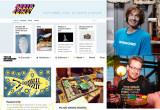
There is so much that you can solve and make yourself! Why adapt your ambition to what is available for you?
For this evening we managed a great line up; Joris van Tubergen, designer, inventor and expert in the field of 3D printing and Stijn Kuipers, Lead Designer @ This is not Rocket Science and Nadya Peek, from the Machine Agency research group at Washington University focussing at harnessing the precision of machines for the creativity of individuals.
So expect creative design, sustainable design, audiodesign, digital fabricage and a lot of inspiration!
Introduction Data Sharing via EU CEF Context Broker Building Block

The European Commission's CEF Context Broker Building Block is holding an introduction webinar on 18 February 2021, 15:00-16:00 CET Brussels
Register for this webinar to discover Context Broker and gain insights on how Context Broker enables organisations (including but not limited to public administrations) to manage and share data in real-time describing “what is currently happening” within their organisations, in the real world they manage or where they run their daily business processes.
Context Broker is a standard based API, a digital platform component that enables the integration of gathered data including insights for further exploitation.
- Data Broker: Assemble information from different systems, eventually belonging to different organisations, instead of having them perform in separate silos.
- Leverage Investments: Enable the creation in the Digital Single Market (of portable and interoperable solutions) a data marketplace.
- Easy Development: Reduce costs and time in the development of context information based platforms and solutions. Experience has shown that it is possible to create meaningful dashboards in a few days!
Context Broker is a standard-based API allowing users to collect, integrate and contextualise data in real time. It is often used by cities to track actions in real-time and then make real-time decisions.
Advies Digitaal duurzaam - Overheid moet sturen op duurzame digitalisering

Digitale technologie en datagebruik veranderen onze samenleving ingrijpend. Dit heeft grote gevolgen voor de duurzaamheid van onze leefomgeving. Hoewel digitalisering en duurzaamheid onlosmakelijk met elkaar zijn verbonden, is hiervoor onvoldoende aandacht in het overheidsbeleid. In zijn advies ‘Digitaal duurzaam’ concludeert de Raad
voor de leefomgeving en infrastructuur (Rli) dat de overheid veel krachtiger
moet ingrijpen in en gebruik maken van de digitale wereld om duurzaamheid te
bevorderen.
Smart Health Amsterdam is looking for an intern Communication & Events
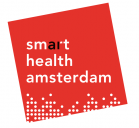
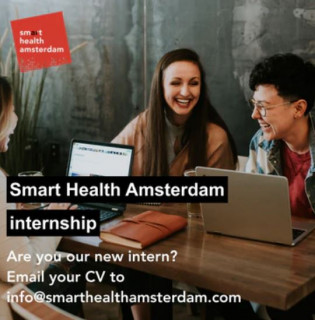
Looking for an internship where you can develop new skills in communications, marketing, PR and event management? Do you have an interest in how AI & data science can contribute to a healthier society and better medical care? Want to work as part of a fun and inspiring team?
As Amsterdam’s key network for data- and AI-driven innovation Smart Health Amsterdam (Gemeente Amsterdam & Amsterdam Economic Board) in #the #life #sciences and #health sector, we’re looking for an intern. Interested? Get in touch today.
https://smarthealthamsterdam.com/p/jobs-at--smart--health--amsterdam Smart
Sixty Minutes Back to the Future: Imagination and Urban Technology, Shaping the Smart City

Technology is everywhere: glued to other hands, integrated into our cars, or hidden behind garbage bins in your street. These technologies change the way we are in the world and experience it. For example, an urban walk is very different if you are efficiently using Google Maps to go from A to B, than if you are quietly strolling in the sunset. When was the last time that you got lost in the city or established a random conversation with a stranger while asking for directions? The introduction of technology in our cities disrupts how our society operates, calling for reflection and debate about the values that we hold important.
Building on insights from post-phenomenology, we reflect on the intricate nature of human-technology relations in the city, broadening it to a society-technology relation. Then, we reflect on how to turn these insights into practice. What do we need to not only reflect on and analyze past or current practices, but to foster our imagination and collective sense-making to take action towards inclusive and responsible practices? What role can design and futuring play in this?
In this lecture, Anouk Geenen and Julieta Matos-Castaño will employ an interdisciplinary approach to reflect on different theories and scholars that help us to create more responsible practices in our technological cities. Moving from Philosophy of Technology to Design Research, and bridging insights on issues and imagination, we follow a broad path of thinkers that broaden our horizon.
Smart Boilers, Salderingsregeling, Kansen voor Energie Flex

Interesse in SmartEnergy voor woningen en bedrijfsgebouwen? Meld je aan voor het 3e webinar van de Smart Energy Community op 9 februari 2021!
We beginnen met Hans de Heer van DNVGL. Hans zal ingaan op het rapport over de waarde van flexibiliteit in de gebouwde omgeving.
Aansluitend zal Ruut Schalij van eRiskgroup ons meenemen in de kansen die de afschaffing van de salderingsregeling biedt aan ondernemers en eigenaren van PV systemen.
Daarna volgt een PowerPitch van een inspirerende ondernemer: Jan Willem de Jong van iwell legt aan de hand van praktijkvoorbeelden uit hoe je batterij-opslag op zinnige manier toe kan passen.
We sluiten af met Evert Jan Althuis van Eneco Strategy & Innovation. Evert Jan zal ingaan op de SlimmeBoiler Module van Eneco. Waarom is het aantrekkelijk voor Eneco om boilers slim aan te sturen? En waar zit de winst voor de klant?
Doe mee en sluit je aan bij de Smart Energy Community!
Programma en registreren: http://bit.ly/SEC_09feb
Dit evenement is in het Nederlands.
Smart City projects in Netherlands/Amsterdam
Hello! I do some research for my company and I have to find out who (companies) are the players in the Smart City market (Netherlands/Amsterdam) who have successfully implemented projects without specializing in just one solution - so here I'm looking who offer complete smart city offers that combine several solutions (e-waste, e- bike, e-mobility, smart bench, smart light, smart parking….)? Thank you!
Nieuwe website Onderneeminalmere.nl
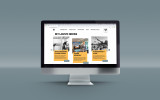
Almere is in ruim 40 jaar een ondernemende stad van betekenis geworden. Er zijn meer dan 18.000 bedrijven gevestigd en er is nog steeds volop ruimte voor groei. De ligging langs de A6, A27 en Hanzelijn en de nabijheid van Schiphol zijn gunstig en de beroepsbevolking is relatief jong. Om dit alles nog beter voor het voetlicht te brengen, hebben de afdeling Economische Zaken en het Ondernemersplein van de Gemeente Almere samen met Almere City Marketing een nieuwe website gelanceerd: www.onderneeminalmere.nl.
Doel van de website is om Almere op de kaart te zetten als dé plek om te ondernemen. De focus ligt daarbij op de sterke punten van Almere als stad om te ondernemen, om zo nieuwe ondernemers en bedrijven te werven en zich te vestigen in de stad. In 2017 won de stad de titel Beste Binnenstad en in 2019 werd Almere gekozen tot MKB-vriendelijkste stad. Almere heeft de ambitie om de economische ontwikkeling van de stad te versterken, zodat een robuuste lokale economie ontstaat. De focus ligt daarbij de komende jaren op ICT- Tech, logistiek, toerisme en recreatie, startups en scaleups en circulaire economie.
Almere heeft en geeft letterlijk en figuurlijk ‘ruimte om te ondernemen’. Hiervoor zijn prachtige verhalen verzameld over ondernemen in Almere. Belangrijk, want er zijn hier geweldige bedrijven actief en de stad heeft op zakelijk gebied veel te bieden. Op de nieuwe website is van alles te vinden op zakelijk gebied. De belangrijke thema’s uit de economische agenda worden belicht, evenals de bedrijventerreinen met de beschikbare bouwkavels. Daarnaast is er een agenda met alle business events. Voor ieder type ondernemer is er relevante informatie te vinden, bijvoorbeeld om contact te leggen met de gemeente, zakelijke partners te vinden of over vestigingsmogelijkheden in de stad. Ook het Ondernemersplein is een belangrijk onderdeel van de website. Starters, zzp’ers, mkb’er en ondernemers in zwaar weer kunnen hier terecht voor praktische informatie, programma’s, events en advies.
Branchevereniging ICT en Telecommunicatie Grootgebruikers (BTG) is partner van Amsterdam Smart City
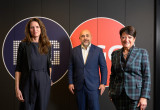
Branchevereniging ICT en Telecommunicatie Grootgebruikers (BTG) sluit zich als Associate Partner aan bij Amsterdam Smart City. Dit betekent dat we onze netwerken aan elkaar verbinden, relevante verbindingen leggen en gezamenlijke events organiseren. BTG is ook lid geworden van de Network Council van de Amsterdam Economic Board.
“Bij het netwerk van Amsterdam Smart City gaat het om het maatschappelijk waardevol inzetten van technologie. Publieke waarde creëren, en technologie inzetten vanuit een menselijk perspectief. Met BTG delen we deze doelstelling en hebben we een gedeeld, maar zeker ook aanvullend netwerk. Hiermee kunnen we elkaar versterken en samen nog meer waarde aan onze maatschappij toevoegen”, aldus Leonie van den Beuken, programma directeur Amsterdam Smart City.
“De digitalisering verandert onze wereld razendsnel; met COVID-19 en de uitrol van 5G als recente aanjagers. BTG zet vol in op deze digitale versnelling samen met haar Solution Partners en Leden. Op deze wijze wordt de leefbaarheid in steden en regio’s verhoogd. Nieuwe innovaties in het smart domein staan hoog op de agenda bij BTG door de inzet van de diverse Expertgroepen op het vlak van IoT, 5G, AI, Security, Smart Society etc. De verkregen best practices worden door BTG ingezet bij het Amsterdam Smart City netwerk. Co-creatie en complementaire
werking, pur sang,” aldus Petra Claessen, CEO BTG/TGG.
Het partnership heeft al geleid tot het gezamenlijk organiseren van twee events in november vorig jaar. Onder de noemer ‘De mindset voor een menselijke slimme stad’ en ‘Hoe kan 5G bijdragen aan verduurzaming van steden?’ hebben we twee bijeenkomsten georganiseerd waarin we met belangrijke stakeholders in gesprek zijn gegaan over de vragen 'Hoe creëren we duurzame en leefbare steden?' 'Hoe kan technologie hierin een nuttig middel zijn?' 'Hoe zetten we mensen centraal in deze steden en nemen we hun waarden mee in de ontwikkeling?'
Bekijk hier de Highlights van beide events.
Belijk hier een verslag van ‘De mindset voor een menselijke slimme stad’
Metropolitan Mobility Podcast: De stad slimmer en schoner van goederen voorzien?
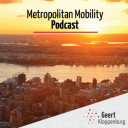
In deze podcast gaat Geert Kloppenburg in gesprek met Walther Ploos van Amstel en Carin ten Hage over digitale voorwaarden voor gezonde stadslogistiek. Luister hier de podcast: http://bit.ly/38ASVZ
Future Fitness Garden
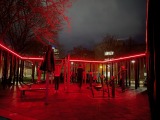
Getting fit and healthy again in 2021? Since the citywide lockdown, members of local sport-clubs have been forced outdoors. One of the most popular (outdoor) fitness areas on the Amsterdam waterfront has been the Marineterrein. In our latest project “Future Fitness Garden” we explore how smart lighting can remind us of safe distancing and capacity in public space during Corona.
Using algorithms we can anonymously detect proximity and density of people working out. For example if they come within 1,5 meters to one another the LED strips turn BLUE. If there are too many people occupying the area the LED will turn RED. This system gently reminds guests to respect each other’s space while sharing the future fitness garden.
Thanks to project partners Marineterrein Amsterdam. Compliments to AI genius Markus Pfundstein, Electrical Mechanical Wizard Werner Pfundstein
Knowledge Quest: Submit Your Example of a Great High Density Environment

Do you know a great example of high density living environments built within the last 30 years? Share your knowledge and contribute to the creation of an open repository via Crowd Creation. To be truly exemplary, the area should include a mixture of functions (at least some of them high-rise) where the physical fabric retains a human scale at street level despite the high density.
You may wonder who's asking for and compiling this information: the Chair of Spatial Urban Transformation at the Amsterdam University of Applied Sciences is committed to building an open-access repository. Sharing best practices across the globe is becoming increasingly vital, especially as many of our western cities are on the eve of unprecedented densification. As a humble thank you for helping to guide this societal challenge, they've allotted 12 rewards for contributors. Click here to submit a project.
Societal Context
Like many of our Western cities, Amsterdam is on the brink of intensive urban densification. The metropolitan area of Amsterdam plans to add 100,000 new dwellings, mostly within the existing urban fabric. Compact studio apartments and new situational typologies of high-rises are part of the program, which will increase the densification even further. How are we to retain a human scale in these new high-density environments, especially at the street level where our social fabric is shaped? This calls for a new array of examples and precedent studies of successful existing "Great High Density Environments." What are their design properties and how are they programmed? How do they succeed in retaining a human scale?
 Amsterdam - Image Courtesy of Amsterdam University of Applied Sciences
Amsterdam - Image Courtesy of Amsterdam University of Applied Sciences
Sensing Streetscapes Project
These questions are central to the Sensing Streetscapes Project initiated by the Chair of Spatial Urban Transformation at the Amsterdam University of Applied Sciences (AUAS). In a consortium of spatial design offices and clients of large scale projects, action research is explored along three lines. First, building on the classic works of Allan Jacobs, Jan Gehl and the like, six of the most-used reference locations for these new environments are deconstructed by research through design. Second, neuro-architectural technologies (eye-trackers) are deployed to uncover the visual impact of the applied design principles: What are the patterns? Do these design solutions indeed mitigate the high density and intensity to a human scale on the level of the streetscape? Finally, an algorithm is developed to trace the most suitable best practices via AI. That’s where you come in.
 Cassilis Road, London - Image Courtesy of Amsterdam University of Applied Sciences
Cassilis Road, London - Image Courtesy of Amsterdam University of Applied Sciences
Repository of Great Examples by Crowd Creation
Some high profile examples of great high density environments are well known, like in Vancouver, Toronto, London, Manchester, Amsterdam, Hamburg, and Manhattan. Yet what lesser-known examples of Great High Density Living Environments are out there for us to learn from? Share your knowledge and contribute to the creation of an open repository via Crowd Creation.
In order to frame the search, a list of desired characteristics:
- Residential environment in an inner city area
- Built within the last 30 years – or about to be 'opened' soon
- Built for High Density with some high-rise buildings
- Success in creating a human scale at eye-level on the street
- Some level of mixed functions, green design, etc. - anything that increases the livability of the environment
Click here to submit a project.
 Hardman Street, Manchester - Image Courtesy of Amsterdam University of Applied Sciences
Hardman Street, Manchester - Image Courtesy of Amsterdam University of Applied Sciences
You are, of course, allowed to offer one of your own projects as an example. The deadline for submissions is January 29th, 2021 and as a modest gesture of thanks for helping address this societal challenge, 12 rewards are available to contributors. Out of the projects that fit the characteristics, consortium members will select the contributors who delivered either multiple great examples, surprisingly interesting examples, or in-depth descriptions and pictures. 12 entrants will be randomly selected to be rewarded:
- 2 will receive personalized book selections on this topic (favorites of the Chair)
- 6 will receive an Amazon gift card with a value of €50
- 4 will receive a ticket to the Media Architecture Biennale 2021
- Winners will be notified personally
Visit the results at https://sensingstreetscapes.com. The website will remain open afterwards, so feel free to keep sending your examples!
Check the recording of our event 'Data Dilemmas: Digital twins - hype or necessity?'

With the growing availability of data and technology, digital versions of objects or systems are getting more interesting. Pairing the virtual and physical world, it is possible to continue critical physical processes while digitally experimenting and looking for improvements. The ‘digital twin’ therefore is an interesting feature, also in urban development.
In a discussion with a number of digital twin projects, we addressed opportunities and barriers. Are current projects more than 3D models? What are the key enablers and challenges in starting digital twins for urban applications? Which steps are the most difficult to implement? Do we fully trust on the system and will reality be handled by a computer? How are decisions for further development made?
Speakers:
- Wietse Balster - geo information advisor at City of Amsterdam
- Eric Jeansson - project manager at City of Gothenburg
- Paolo Pileggi - IT program developer & Walter Lohman - project lead at TNO
Moderator:
- Leonie van den Beuken - program director Amsterdam Smart City
Catch the presentations here:
Business transformation through IoT
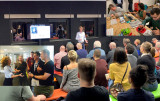
Every 3th Wednesday, the Sensemakers Amsterdam community invites interesting speakers, this evening ao:
Boban Vukicevic is a startup mentor, supervisory board member digital transformation and university lecturer Smart Services (Internet of Things for Business) at Open University where he shares his insights on the conditions necessary for a successful IoT implementation and the associated digital transformation of a company. The highlights will be shared with us in this talk!
HackNotCrime & Robotic Wearables

Every 3th Wednesday SensemakersAMS invites interesting speakers, this evening:
- Jilles Groenendijk, hardware hacker, on the importance of hacking your hardware before using it!
- Designer and Innovator Anouk Wipprecht is working in the emerging field of "FashionTech"; a rare combination of fashion design combined with engineering, science and interaction/user experience design. Producing impressive robotic wearables with systems around the body that tend towards artificial intelligence, like her Intel-Edison based spider dress.
In this talk she will share some of her projects and the way she approaches the technical and design challenges.
Smart Energy voor woningen en bedrijfsgebouwen: focus op Smart Charging. 12 januari 2021 - 15.00 uur

Interesse in Smart Charging bij woningen en bedrijfsgebouwen? Meld je aan voor het 2e webinar van de Smart Energy Community op 12 januari 2021!
We beginnen met Roland Steinmetz van EVConsult. Roland zal ingaan op het organiseren van toekomstvaste laadinfrastructuur bij bedrijven.
Dan hebben we 2 PowerPitches van inspirerende ondernemers:
* Welke kansen biedt e-mobility aan fleet-owners? Oscar Westerhof, PowerD
* Energy-management voor laadpalen, batterijen en opwek. Jan-Willem Heinen, Maxem Energy Solutions B.V.
We sluiten af met Maarten Berende van Enexis Groep, over een experiment met aansturing van de thuislaadpunten van 140 huishoudens: zou het lukken om tegelijkertijd het elektriciteitsnet te ontlasten en toch bij iedereen voor een volle accu te zorgen?
Programma: https://bit.ly/SmartEnergyCommunity
Registreren: https://bit.ly/SEC2_subscribe
Dit evenement is in het Nederlands / This event is in Dutch.
#SmartHome #FlexibleEnergy #SmartBuildings #SmartCharging
Hogeschool van Amsterdam gaat mkb helpen met digitalisering

FOR ENGLISH CLICK HERE
Staatssecretaris Mona Keijzer heeft dertien mkb-deals ondertekend. Daarmee draagt haar ministerie van Economische Zaken en Klimaat (EZK) met ruim zeven miljoen euro bij aan regionale mkb-projecten van provincies en gemeenten. Bedrijven krijgen daardoor een impuls om te innoveren, digitaliseren en internationaal te opereren. De Hogeschool van Amsterdam (HvA) is bij twee deals over digitalisering betrokken; een belangrijke speerpunt binnen de hogeschool.
In de regio’s Groot-Amsterdam en Gooi en Vechtstreek gaat de HvA mkb’ers helpen met digitaliseringsvraagstukken. Waar mogelijk wordt binnen de twee deals samengewerkt. Veel ondernemers willen en moeten wel aan de slag met digitalisering, maar hebben het gevoel kansen te missen. Zo hebben mkb’ers moeite om zich aan te passen aan bepaalde tekorten op de arbeidsmarkt, de opkomst van (digitale) platformen, verduurzaming, globalisering en recent COVID19.
Digitaliseringsoffensief voor mkb in regio Groot-Amsterdam
In de regio Groot-Amsterdam heeft het HvA Expertisecentrum Applied Artificial Intelligence samen met partners het mkb Digitaliseringsoffensief gelanceerd. Dit project draagt bij aan de kennis en kunde van ondernemers op het gebied van kansen (gebruik van data, online marketing, sales en automatisering), risico's (veilig ondernemerschap) en het gebruik van digitale tools.
Met het digitaliseringsoffensief wil het consortium in Amsterdam minimaal 30.000 mkb-bedrijven bereiken om hen te wijzen op de kansen en mogelijkheden van digitalisering. Aan minimaal 750 bedrijven wordt een zelfscan aangeboden, waarna ze doorverwezen worden naar diverse online trainingen op het gebied van digitalisering en data-analyse, passend bij het volwassenheidsniveau van hun bedrijf.
Via een online platform wordt het mkb gekoppeld aan mkb-bedrijven die al innovatief bezig zijn en kennis kunnen delen. Voor mkb-bedrijven die echt intensief met digitalisering aan de slag gaan, zijn er intensieve trainingstrajecten en coaching. Vanuit het expertisecentrum zal het lab dat zich richt op retail en marketing - het Centre for Market Insights - het mkb gaan helpen met de eerste stappen van digitalisering (onder meer ontwikkelen van de zelfscan en online trainingen).
Het consortium voor het mkb Digitaliseringsoffensief bestaat naast de HvA uit MKB Amsterdam en Ready to Scale (onder leiding van Stichting THE Startup Network). De gemeente Amsterdam heeft de deal geïnitieerd.
Lees in het digitaal magazine meer over de mkb-deal in Groot-Amsterdam
Digitaal en fysiek loket voor mkb’ers in Gooi en Vechtstreek
Met de andere mkb-deal gaat de HvA mkb’ers in de regio Gooi en Vechtstreek digitaal klaarstomen. Het project SPOT 035 organiseert een digitaal en fysiek loket voor mkb’ers met digitaliseringsvragen. Op het Media Park in Hilversum krijgen ondernemers toegang tot een regionaal netwerk van studenten, kennisinstellingen en ‘digital frontrunners’ (toonaangevende technologie- en mediabedrijven).
Het online en fysieke platform biedt voorlichting, helpt bij het opstellen van een digitaliseringsstrategie en begeleidt ondernemers in de stap naar realisatie en financiering. De HvA heeft bij SPOT 035 de lead, omdat zij veel ervaring heeft met het oplossen van digitale vraagstukken van bedrijven. Bovendien is het een van de manieren waarop de HvA haar doelstelling - bedrijven en professionals helpen met transformatie- en kwalificatievraagstukken - ook echt in de praktijk kan brengen. Het project heeft als doel dat meer mkb-bedrijven met digitalisering aan de slag gaan, waardoor zij bestaansrecht hebben en houden, groeien of zelfs nieuwe business gaan opzetten.
Voor SPOT 035 werkt de HvA nauw samen met de gemeente Hilversum, regio Gooi en Vechtstreek, BV Hilversum, MBO College Hilversum en Media Perspectives.
Lees in het digitaal magazine meer over de mkb-deal in Gooi en Vechtstreek
OpenADR in Europe. Smart Charging & Smart Appliances

OpenADR enables Flexible Energy solutions for a more stable grid. It started in 2002 in California, and is already more than 10 years available now.
OpenADR is implemented in various European projects. To share knowlegde about these, OpenADR hosts 2 webinars focussing on Europe. The first will be December 15th. We will have speakers from Stromnetz Hamburg, ChargePoint, U.K. Department of Business, Energy and Industrial Strategy, CERTH & Universidad Politécnica de Madrid, and of course OpenADR
15 December 2020 - 15.00 CET.
Register here, and check program (free event):
https://bit.ly/openADR_EUROPE
Data Dilemma’s: Digital twins – hype or necessity?

With the growing availability of data and technology, digital versions of objects or systems are getting more interesting. Pairing the virtual and physical world, it is possible to continue critical physical processes while digitally experimenting and looking for improvements. The ‘digital twin’ therefore is an interesting feature, also in urban development.
Governments are exploring what a digital twin can mean for them or have already taken the first steps. Some with a clear output or use case in mind, some to experiment and build upon for the future. Setting up a digital twin of a city or region is complex and could therefore become costly. A digital twin may even grow into a
system where no one is able to comprehend how an implication has come about anymore.
In a discussion with a number of digital twin projects, we will address opportunities and barriers. Are current projects more than 3D models? What are the key enablers and challenges in starting digital twins for urban applications? Which steps are the
most difficult to implement? Do we fully trust on the system and will reality be handled by a computer? How are decisions for further development made?
Join us for these and of course the questions from the audience during this session of Data Dilemmas on the 17th of December!
Program:
Online event
Date: 17th of December 2020
Language: English
15.50: Digital walk-in
16.00 – 16.05: Introduction by Amsterdam Smart City & Datalab
16.05 – 16.45: Presentations + Q&A
Speakers:
- Wietse Balster - geo information advisor at City of Amsterdam
- Eric Jeansson - project manager at City of Gothenburg
- Paolo Pileggi - IT program developer & Walter Lohman - project lead at TNO
16.45 – 17.15: Plenary discussion and wrap-up
Sign up: https://www.eventbrite.com/e/data-dilemmas-digital-twins-hype-or-necessity-tickets-131311784081
About the Data Dilemmas series
Digital Twins show us that possibilities of using data and new technologies to address urban challenges are endless. We use data to make cities safer, cleaner and, for example, more accessible. But do we really need the data in all cases? What happens to all the data that is collected? Which choices did people make and why? Which dilemmas can be encountered? These questions are important for everyone; for governments, knowledge institutions, residents and companies. Amsterdam Smart City likes to explore with you which decisions are needed for responsible use of data.
Data Dilemmas is a collaboration between Amsterdam Smart City and the City of Amsterdam’s Datalab.
Transforming citizen sensing

A two day conference on open source hardware for air quality measurement across borders.
This is an online event. Information on how to join the meetup will follow after registration.
//
In many corners of the world, people choose to measure local air quality out of concern for their neighbourhood, their health, the climate or agriculture. These citizens collect data with the help of affordable and accessible sensor technology and sometimes come together to be part of a citizen sensing network - think of the global networks of open source hardware such as GOSH and Hackteria. And then there are international sensor communities, such as global platform Sensor.Community, Public Lab and Smart Citizen kit, and Dutch initiatives, such as Snuffelfiets, Meet je stad and Hollandse Luchten. These citizen sensing initiatives now have a wealth of knowledge and experience in making open source sensors. They form sensing communities that collaborate successfully on a local level. This often takes root in top-down measurement programmes aimed at a specific group in a specific location. But air quality knows no borders — it is an urgent matter across the globe. It’s about time we share knowledge, learn from each other, and make sensor technology accessible to a broad and international group with a common environmental concern.
On Wednesday December 9th and Thursday December 10th Waag and SODAQ will organise the Transforming citizen sensing conference. During this two-day conference, a wide variety of citizens, environmental activists, makers, ecologist, technical experts and researchers will come together to discuss their concerns and needs around air quality measurement. Global sensing initiatives are invited to share their knowledge. The goal is to identify the requirements a sensor should meet in order to address the common issue and to discover the limits of what is technically possible.
Involve the user in the design process
The production process of (sensor) technology is often inaccessible to the consumer, who has little or no say in the subject of the product. During this conference, the communities that use sensor technology will be involved in the first phase of the design process. This open production process is also referred to as open source hardware (OSH). Open source hardware is not only about transparent, accessible and reproducible hardware, but is mainly aimed at a participatory and community-driven design process. The experiences of communities form the basis of the design and the entire process (from design to prototype to product) is transparent for users.
What concerns are most pressing globally? What design challenges do these concerns present to sensor making? And what can we learn from experienced open source hardware initiatives around the world? Join us to find out.
Your input will be considered during the development of Sodaq and Waag’s open source prototype.
Day 1 | sensor making: from use case to design challenge
On day one we will start with presentations by sensing initiatives. What prompted them to start the initiative, what lessons have they learned, what was the biggest design challenge and how do they involve the community? After this there will be a joint discussion about the bottlenecks in measuring air quality and we will go deeper into why and what air quality sensors can help for. We will end this day with a clear overview of the needs of the participants and the related design challenges. In addition, we will let you know what role participants have in the further development of the sensor.
When: Wednesday December 9
Time: 7:00 pm - 9:15 pm
Programme
19:00 hrs - Introduction programme
19:05 hrs - Presentation use cases*:
- Lukas Mocek, Sensor.Community
19:40 hrs - Q&A
19:50 hrs - Break
20:00 hrs - Sharing concerns and identify needs
20:30 hrs - Formulate design challenges
21:15 hrs - End
Day 2 | from design challenge to first sensor concepts
On day two, sensor makers will share their knowledge on: electricity, internet connection, sensor technology, modularity, software, data quality and data visualisation. In groups, researchers, data specialists and citizen initiatives will work on the design challenges of day one. Your input and knowledge will therefore have a direct impact on the sensor that will be developed in 2021. At the end of the day, you will know the latest developments in (air quality) sensors, you will have gotten to know other makers, you will have made an active contribution to the design of a new air quality sensor and you will be part of a worldwide network of sensor makers.
When: Thursday December 10
Time: 7:00 pm - 9:15 pm
Programme
19:00 hrs - Introduction programme
19:05 hrs - Presentation use cases*
19:40 hrs - Q&A
19:50 hrs - Break
20:00 hrs - Design challenge
20:35 hrs - Presents results
21:15 hrs - End
* Speakers will be announced on this page shortly.
Do you have experience in making sensors and would you like to share your knowledge with others in the field? And do you want to be part of a worldwide, open source hardware community?
join us online on december 9 & 10
Open Next
The Transforming citizen sensing conference is part of the European Open Next project. This open source project links to the maker movement. This movement reduces the distinction between professional makers and amateurs. Open source hardware (OSH) is an important part that contributes to this. It makes knowledge sharing available in an accessible way, so that innovation and the do-it-yourself culture is reflected in the home and at work.
This means that products or services are no longer designed to be patented, expensive or closed, but rather accessible and transparent. A well-known platform for OSH is Wikifactory. Here everyone can share his or her idea, but also improve and recreate ideas or products from other people. For proprietary rights, you can choose from several tested and established certificates such as, FOSS (based on OSH), Creative Commons(which is linked to different creative products) or CERN, which focuses on specific OSH and offers a choice of both commercial and non- commercial goals. For example, a non-commercial certificate no longer protects a complete product, but can be opened up under a number of conditions. Consider releasing construction drawings of an air quality sensor so that they can be downloaded from anywhere in the world. In this way you give people at home or at work the opportunity to build something themselves with which to measure their air quality and you increase the range and reliability of the measurements. This way of working has an impact on the traditional business model and deserves a redefinition in today's society. The certificates mentioned make it possible to enter into an inclusive collaboration during the design and development phase and can be extended to the development of new versions. Citizens and communities can then be involved based on their needs and/or skills.
Waag en Sodaq
Waag previously developed the HoLu sensor with participants from the local measurement communities of Hollandse Luchten. They deal with air pollution on a daily basis and are concerned about their health, environment and climate. By formulating the design questions together with them, we ensure that the technology serves what the citizen scientists need. Waag and Sodaq are working together and are investigating how the HoLu sensor kit can be further developed into a sustainable sensor based on open source hardware. Sodaq is specialised in developing sensor technology with an interest in open-source hardware developments. Together we work towards the goal of developing an air quality sensor based on input from a wide audience, so that we can make sensor technology accessible at a global level and thus connect with other communities where the theme of air pollution is urgent. The results of the conference and the design drawings will be shared here at a later stage. In January we organise a series of design prints that you can be part of.
Stay up to date
Get notified about new updates, opportunities or events that match your interests.

